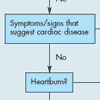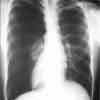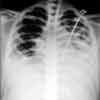Pediatric Chest Pain: Keys to the Diagnosis
Chest pain in children evokes anxiety in patients and their parents--and prompts frequent visits to the pediatrician's office, urgent care facility, or emergency department (ED). In a prospective study, Selbst and colleagues reported that chest pain accounted for 6 in 1000 visits to an urban pediatric ED.
Chest pain in children evokes anxiety in patients and their parents--and prompts frequent visits to the pediatrician's office, urgent care facility, or emergency department (ED). In a prospective study, Selbst and colleagues1 reported that chest pain accounted for 6 in 1000 visits to an urban pediatric ED.
Pediatric chest pain is often benign. Studies have shown that without a specific indication, routine tests--including echocardiography and exercise stress testing--are of no benefit in determining the cause of chest pain.1-3 Nevertheless, chest pain is one of the leading reasons for referral to a cardiologist.2
Here we provide a comprehensive review of the causes of chest pain in children. We also suggest a clinical approach to the evaluation, diagnosis, and management of pediatric chest pain (Algorithm). Such an approach will help ensure that unnecessary investigations are avoided and rare but potentially life-threatening disorders are identified.
CAUSES OF CHEST PAIN
Chest pain in children is rarely the result of cardiac abnormalities or life-threatening conditions.1-4 Chest pain may be associated with pathology of any of the pain-sensitive structures in the chest, neck, and abdomen. It may arise from the chest wall, lungs (pleura), heart, mediastinum, esophagus, or trachea, and it has no sex predilection.1
Skin and musculoskeletal structures. Structures in the chest wall are the most common source of chest pain in children.2-6 Muscle injuries or strain in the pectoral, shoulder, or back muscles secondary to trauma or physical activity are frequent causes of chest pain. Repeated use of chest wall muscles during protracted coughing leads to muscle discomfort from strain.
Costochondritis usually presents as chronic sharp pain in the anterior chest wall that may radiate to the back or abdomen. The pain is exacerbated by deep breathing and physical activity and may be preceded by upper respiratory infections or exercise. Pain related to costochondritis may last for months; typically, it is reproducible by the application of pressure at the costochondral junction. Infections from coxsackie virus may also cause chest pain (pleurodynia). Herpes zoster (shingles) causes pain in the chest wall that may precede the typical vesicular rash eruption.
Respiratory/pulmonary. Patients with pleuritis have sharp chest pain that makes them catch their breath. Deep breathing and coughing usually exacerbate the pain. Pleuritic pain is sometimes referred to the abdomen and shoulder because of the common sensory nerve supply.7 A rub may or may not be audible on chest auscultation.

Pneumothorax, another cause of chest pain of acute onset, may be spontaneous or secondary to lung pathology or trauma. The patient usually presents with breathlessness and pain of variable severity. Spontaneous pneumothorax is more common in children and adolescents who have marfanoid features (tall, thin build and arachnodactyly).8 Acute asthma exacerbations may also cause chest pain.9
GI system. Inflammation of the upper GI tract (gastritis, esophagitis) accounts for 5% to 10% of pediatric chest pain.2-6 The pain typically is located retrosternally and is aggravated when the child eats or leans forward. Gastritis often coexists with esophagitis and is a more likely diagnosis if the child is taking oral cortico- steroids or NSAIDs. Also consider the possibility of foreign-body impaction in the esophagus, especially in younger children or in children with developmental delays.
Cholecystitis and choledocholithiasis may be seen in obese adolescents and patients with hematologic disorders such as sickle cell disease and hereditary spherocytosis. This pain is often localized to the epigastrium, lower right rib cage, back, or right shoulder.10
Hepatitis is often associated with pain in the right upper quadrant of the abdomen. Reproducible tenderness may be noticed in the intercostal spaces of the overlying chest wall.
Cardiovascular. Chest pain attributable to cardiovascular lesions occurs in only about 4% to 6% of children with chest pain2-6 but is the scenario that is most feared by the patient, family, and pediatrician. Although such lesions are potentially life-threatening, early identification can prevent morbidity and mortality. Be especially vigilant with children who have a history of such disorders as Kawasaki disease and aortic valve stenosis. These conditions may present with symptoms and laboratory and ECG findings that suggest myocardial infarction.
Acute pericarditis causes a stabbing, sharp pain that may worsen when the patient is supine and improve with sitting. The presence of a frictionrub is a useful but variable sign in acute pericarditis. Larger fluid collections in the pericardium may lead to absence of a rub, and muffled and distant heart sounds may be the only auscultatory findings. Still larger collections may lead to cardiac tamponade with neck vein distention, narrow pulses, tachypnea, and tachycardia. Pulsus paradoxus can be elicited in patients with cardiac tamponade.
Typical ECG findings include generalized low voltage from the damping effect of fluid. Generalized ST-segment elevation may result from fluid pressure on the myocardium. Electrical alternans, characterized by variable QRS amplitude, may be observed.
Chest radiographic findings vary according to the volume of pericardial fluid. Larger collections typically cause the heart to appear globular or assume the classic "money bag" shape. Emergency pericardiocentesis can be a life-saving procedure in cardiac tamponade. Biochemical and microbiologic evaluation of the tapped pericardial fluid often reveals the underlying cause of pericardial effusion.
Myocarditis, either alone or in association with pericarditis, may cause chest pain. Depending on the area of myocardium involved, the ECG may show arrhythmias or ST- segment changes.
Hypertrophic obstructive cardiomyopathy, a familial condition, can present with syncope and angina-like chest pain in children and adolescents and is a known cause of sudden cardiac death.11,12 Suspicion of this disorder usually emergesduring the evaluation of a cardiac murmur or an assessment of fatigue, dyspnea on exertion, palpitations, syncope, or angina-like symptoms. There may be a family history of sudden, unexplained death.
The examination findings include hyperdynamic precordium, double apical impulse, and ejection systolic murmur. Immediate postexercise evaluation may show increased murmur intensity. ECG findings generally include left ventricular hypertrophy with or without ST-segment changes and Q wave changes consistent with a left ventricular strain pattern. Chest radiography typically shows a slight left ventricular cardiac enlargement. Echocardiography usually reveals asymmetric interventricular septal hypertrophy.
Other cardiovascular disorders. Electrocardiography is warranted in a patient who has syncope with a suspected cardiac cause. If the age-corrected QT interval is prolonged--whether or not there is a family history of sudden death--consider a diagnosis of long QT syndrome.
Premature coronary artery diseases are rarely seen in adolescents with hypercholesterolemia and uncontrolled diabetes, although there may be a family history of sudden death from premature coronary artery disease. Case reports of lymphocytic myocarditis in adolescents with angina-like clinical and laboratory findings have also been published.13
Psychiatric. The incidence of pediatric chest pain that has a psychogenic or psychiatric cause is 5% to 17%.2-6 Although these causes represent a diagnosis of exclusion, a trusting relationship between the family and the pediatrician is essential to help elucidate the underlying problems. A variety of psychosocial causes may contribute to psychogenic chest pain; these include a death in the family, familial discord, poor school performance, and social isolation. Psychogenic chest pain is generally seen in children older than 12 years and is more prevalent in girls.1,14
Idiopathic. A thorough history taking and physical examination can help rule out organic and psychiatric causes of chest pain. Nevertheless, a precise cause cannot be identified in many children. The pain typically has a chronic course and often resolves spontaneously.15
Other causes. Patients with sickle cell disease frequently present with chest pain as a manifestation of vaso-occlusive episodes.16 Cocaine abuse is a known cause of angina-like pain, especially in adolescents.17,18 Pubertal breast changes and diseases such as mastalgia and fibrocystic disease may cause chest pain in teenagers.19 Male breast enlargement (gynecomastia) sometimes produces pain and tenderness.20 Mediastinal and chest wall tumors are a rare cause of chest pain in children.21-23
CLUES FROM THE HISTORY
Taking a thorough history is important for an accurate diagnosis (Table). The mnemonic "PQRST" is helpful in describing pain:

Position (location) and palliation
Quality (sharp, dull, burning)
Radiation
Severity (intensity, duration)
Timing (frequency, time of day).
It is also important to elicit factors that aggravate and relieve pain, as well as associated symptoms.
A history of exertional chest pain associated with palpitations and syncope may indicate a cardiac origin. A family history of sudden premature death, heart disease, hypertension, or hypercholesterolemia may also suggest possible cardiac risk factors.
Pain that is associated with eating may point to a gastric or duodenal source. Typically, eating tends to relieve pain that is of duodenal origin, but it can also aggravate gastritic pain. GI pathology is suggested by a history of melena, hematochezia, or hematemesis.
Chest pain that is aggravated or relieved when the patient changes position may offer helpful clues. For example, a patient with pericarditis experiences relief when sitting or leaning forward and exacerbation when lying down.
A history of the use of medication (prescription and nonprescription) and drugs of abuse is important, especially because cocaine use is known to cause angina-like pain.17,18 A history of fever, cough, hemoptysis, or dyspnea points to a likely respiratory source. Pain that worsens with deep inspiration may suggest pleuritis or occult rib fracture. Children who participate in contact sports should also be asked about a history of injuries that may cause chest pain, such as overt or occult rib fracture.
A detailed social history that focuses on the child's relationship with peers, school performance, family dynamics, and potential life stressors should be elicited. A family or personal history of psychiatric disorder is often helpful in determining the cause of chest pain in patients in whom a psychogenic cause is suspected.

CLUES FROM THE PHYSICAL EXAMINATION
A thorough physical examination can often reveal the cause of chest pain. Examine the vital signs for indications of fever, tachycardia, tachypnea, or age-corrected abnormalities in blood pressure. Whenever possible, have the patient score the pain using a standard pain scale.
Physical examination should include identification of marfanoid features, such an atypically long arm span. Reproducibility of chest pain on application of pressure suggests a musculoskeletal origin. Palpate the breasts for tenderness. Bruises or point tenderness may indicate accidental or nonaccidental trauma.
The respiratory evaluation should include assessment of retractions, air entry, and abnormal lung sounds (crepitations and wheezes). Evaluate the heart rate and rhythm and check for the presence of murmurs. Hypotension, hypertension, or gallop rhythm may indicate a potential cardiac cause of chest pain. Vasculitic or photosensitive rashes may indicate an autoimmune cause.
SUGGESTED LABORATORY EVALUATION AND WORKUP
A careful history taking and physical examination usually reveals the cause of chest pain and helps guide subsequent evaluation. A focused workup, rather than exhaustive laboratory evaluation, should be the first step. For example, chest radiography is reasonable if one suspects a fracture or respiratory cause. Chest radiography can detect air-space disease, pneumothorax (Figure 1), pleural effusion (Figure 2), soft tissue swelling, and fractures and identify cardiac size and silhouette abnormalities. Performing a complete blood cell count and blood cultures is reasonable in patients with suspected lung infections. Elevated erythrocyte sedimentation rate is a nonspecific marker of inflammation.
If the history and physical examination suggest a likely cardiac cause, an ECG and pediatric cardiology referral may be indicated. Psychological evaluation and counseling are warranted if psychosomatic causes are likely. A urine drug screen may be useful if cocaine use is suspected.
MANAGEMENT
Identification of the cause of chest pain will determine appropriate treatment. Costochondritis and other musculoskeletal conditions are usually managed with analgesics, especially NSAIDs. Patients with pneumonia are treated with antibiotics and supportive care.Gastritis, peptic ulcers, and gastroesophageal reflux may require pharmacologic treatment; dietary modification may help in uncomplicated cases. In rare cases of potentially life-threatening cardiac causes, inpatient hospitalization with cardiorespiratory monitoring and evaluation by a pediatric cardiologist may be required. Antiarrhythmic medications may be indicated in rare cases that involve arrhythmias or long QT syndrome. Psychological or psychiatric evaluation is sometimes necessary.
Occasionally, even after frequent reassurance and after an organic cause has been ruled out, patients continue to experience symptoms. Analgesics may offer relief during exacerbations. Many children with chest pain experience spontaneous resolution.
References:
REFERENCES:
1.
Selbst SM, Ruddy RM, Clark BJ, et al. Pediatric chest pain: a prospective study.
Pediatrics.
1988;82: 319-323.
2.
Fyfe DA, Moodie DS. Chest pain in pediatric pa-tients presenting to cardiac clinic.
Clin Pediatr
(Phila).
1984;23:321-340.
3.
Pantell RH, Goodman BW Jr. Adolescent chest pain: a prospective study.
Pediatrics.
1983;71:881-887.
4.
Kocis KC. Chest pain in pediatrics.
Pediatr Clin North Am.
1999;46:189-203.
5.
Evangelista JA, Parsons M, Renneburg AK. Chest pain in children: diagnosis through history and physical examination.
J Pediatr Health Care.
2000;14:3-8.
6.
Coleman WL. Recurrent chest pain in children.
Pediatr Clin North Am.
1984;31:1007-1026.
7.
Standring S, ed.
Gray's Anatomy: The Anatomical Basis of Clinical Practice.
39th ed. New York: Elsevier Churchill Livingstone; 2005:1664.
8.
Hall JR, Pyeritz RE, Dudgeon DL, Haller JA Jr. Pneumothorax in the Marfan syndrome: prevalence and therapy.
Ann Thorac Surg
. 1984;37:500-504.
9.
Wiens L, Sabath R, Ewing L, et al. Chest pain in otherwise healthy children and adolescents is frequently caused by exercise-induced asthma.
Pediatrics.
1992;90:350-353.
10.
David DG, Benjamin H. Nontraumatic musculoskeletal disorders: shoulder pain. In: Tintinalli JE, ed.
Emergency Medicine: A Comprehensive Study Guide.
6th ed. New York: McGraw-Hill; 2004:283.
11.
Walsh CA. Syncope and sudden death in the adolescent.
Adolesc Med
. 2001;12:105-132.
12.
Azzano O, Bozio A, Sassolas F, et al. Natural history of hypertrophic obstructive cardiomyopathy in young patients: apropos of 40 cases [in French].
Arch Mal Coeur Vaiss
. 1995;88:667-672.
13. Leeper NJ, Wener LS, Dhaliwal G, et al. Clinical problem-solving. One surprise after another. N Engl J Med. 2005;352:1474-1479.
14. Selbst SM. Chest pain in children. Pediatrics. 1985;75:1068-1070.
15. Rowland TW, Richards MM. The natural history of idiopathic chest pain in children. A follow-up study. Clin Pediatr (Phila). 1986;25:612-614.
16. Taylor C, Carter F, Poulose J, et al. Clinical presentation of acute chest syndrome in sickle cell disease. Postgrad Med J. 2004;80:346-349.
17. Hollander JE, Todd KH, Green G, et al. Chest pain associated with cocaine: assessment of prevalence in suburban and urban emergency departments. Ann Emerg Med. 1995;26:671-676.
18. Woodward GA, Selbst SM. Chest pain secondary to cocaine use. Pediatr Emerg Care. 1987;3:153-154.
19. Ciftci AO, Tanyel FC, Buyukpamukcu N, Hicsonmez A. Female breast masses during childhood: a 25-year review. Eur J Pediatr Surg. 1998;8:67-70.
20. Khanna P, Panjabi C, Maurya V, Shah A. Isoniazid associated, painful, bilateral gynaecomastia. Indian J Chest Dis Allied Sci. 2003;45:277-279.
21. Wongsangiem M, Tangthangtham A. Primary tumors of mediastinum: 190 cases analysis (1975-1995). J Med Assoc Thai. 1996;79:689-697.
22. Marseglia GL, Savasta S, Ravelli A, et al. Recurrent chest pain as the presenting manifestation of spinal meningioma. Acta Paediatric. 1995; 84:1086-1088.
23. Schorry EK, Crawford AH, Egelhoff JC, et al. Thoracic tumors in children with neurofibromatosis-1. Am J Med Genet. 1997;74:533-537.
Recognize & Refer: Hemangiomas in pediatrics
July 17th 2019Contemporary Pediatrics sits down exclusively with Sheila Fallon Friedlander, MD, a professor dermatology and pediatrics, to discuss the one key condition for which she believes community pediatricians should be especially aware-hemangiomas.